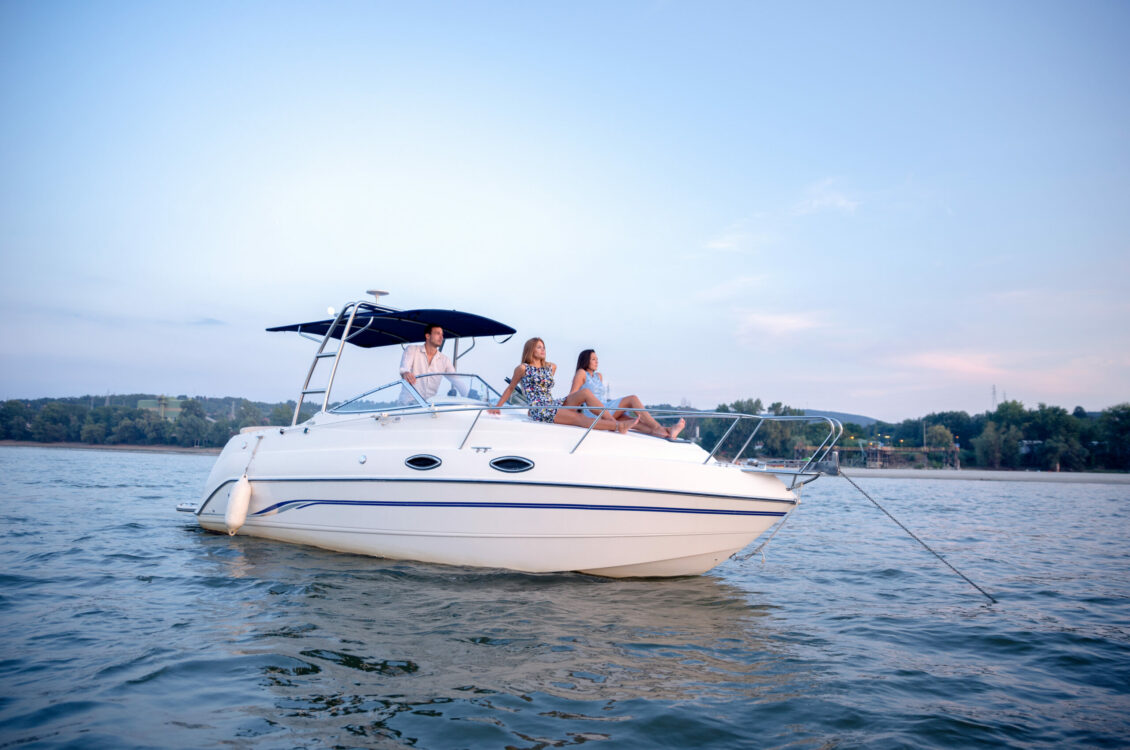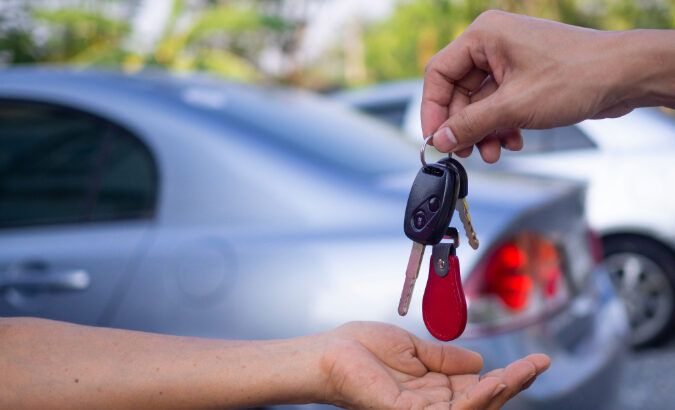
Enjoying a day on the boat with family and friends is unbeatable, but it’s important to make sure you don’t forget to prioritize safety while enjoying the waves. Check out these important boating safety tips before you begin the season:
1. Be prepared with a boat safety kit
You can’t always predict an emergency, so be prepared for any situation. Your boat safety kit should be kept on board no matter the size of your boat. Below are some essential items your safety kit should include.
- Flashlight – A flashlight and extra batteries can help you see around your boat in the dark and allow you to be seen if you run out of fuel or if your craft stalls.
- A bilge pump or bailing device – If your boat starts taking on water, you need a way to get it out. A basic bilge pump or other bailing device will do the trick in many cases.
- First aid kit – A properly equipped first aid kit, plus the know-how to use it, is vital in case of an accident or medical emergency.
- Visual distress signal – You may need a way to attract attention out on the water. Flares or a similar device can be used to do so.
- Whistle – As a recognized signal calling for help on the water, a waterproof whistle is another must-have.
- Ropes – These are critical for pulling someone in who has fallen overboard, securing your craft to the dock and tying down loose items in extreme weather.
- Fire extinguisher – Just because you’re on the water doesn’t mean you can’t have an onboard fire. All passengers should know the location of your fire extinguisher and how to use it.
- Life jackets – You should have a U.S. Coast Guard approved life jacket for every person on board. Read on for information on picking out the right life jackets.
- VHF radio – Phones are not always a surefire communication method when you’re out on the water. A VHF radio doesn’t rely on cell service, allowing you to contact the coast guard or other boaters more reliably.
- A compass – Don’t rely entirely on electronic navigations systems. Having a compass on board will give you a general sense of direction if you lose power.
- Sun protection – Sun exposure can be a serious threat out on the water. Always keep sunscreen with you, plus protective clothing or some other means to cover yourself up. [1]
2. Bring the proper life jackets
Life jackets are essential for safe boating. Even if you’re a strong swimmer, it’s still always a good idea to wear one. From head injuries to the shock of cold water, a lot can affect you between falling out of a boat and being rescued. A life jacket can help keep you from drowning if you aren’t able to tread water on your own power. Laws regarding their use vary from state to state, however the National Safe Boating Council says that every person on a boat should wear one. Choose a life jacket that is right for your height and weight, plus:
- Try it on before purchasing. Fasten the vest, hold your arms straight up over your head and have someone gently pull the top of the arm opening to make sure it fits snugly.
- Auto and manual inflatable life vests can turn an unconscious wearer face up, but they require regular maintenance. They’re also not recommended for children under 16 years of age.
- If you’re going fishing, look for a life jacket with pockets and straps to easily carry tackle and supplies. [2]
3. Check the weather forecast for boating beforehand
Warm, sunny days are ideal for boating, but even on fine days, storms can roll in with frightening speed. In the days leading up to your excursion, check and recheck for changing weather conditions via a trustworthy source like the National Weather Service Marine Forecast. If there’s any sign of bad weather, delay your departure to another time or day. [3]
4. Don’t exceed the boat capacity plate requirements
Every boat over 20 feet in length is required to have a capacity plate that details the weight and approximate number of people the boat can safely carry. This plate is usually fastened somewhere near the steering wheel. Exceeding that limit may put you at risk of capsizing, so always check the limits of your craft before setting off. If your boat doesn’t have a capacity plate, you can find its capacity with the following equation:
Capacity = vessel length x vessel width ÷ 15 [4]
5. Use a boat carbon monoxide detector
Carbon monoxide is a colorless, odorless gas produced by your engine that can accumulate in and around your boat. When breathed in for even a few minutes, it can cause unconsciousness and death. Keeping a carbon monoxide detector in your boat can ensure you are alerted if the gas begins to build up. Be sure to replace your detector every five years or so, or as noted on the detector. [5]
6. Use good judgement when recreational boating
Safety best practices on the water are similar to those you follow on the road. It’s important to use common sense, stay alert at all times, operate at a safe speed and ensure passengers stay safely within the confines of the boat. Never consume alcohol before or while operating a boat, and head in if you notice the weather turning. Be aware of your limits and those of your vessel, and be respectful of both. [2]
7. Follow proper procedures for boat anchoring and docking
It’s just as important to remember safety on the way in as it is on the way out. When docking, always approach at a safe speed (idling is usually best). Your momentum will help carry you in, but if you’re moving too fast, it can also cause you to lose control.
Your maneuvers will depend on the position and type of dock you’re approaching, but unless you’re headed into a slip, it’s generally a good idea to approach at a 30 to 45 degree angle. As you draw close, shift into neutral and let your boat drift in, shifting into reverse in short bursts to reduce speed further if necessary. Secure the bow and stern of your boat to the dock before turning off the engine. [6]
If you’re settling into place out on the water, always properly anchor your boat before doing anything else. After you position your boat, stop its forward momentum and lower your anchor until it reaches the bottom. Then, install a snubber (a flexible line that absorbs shock from the anchor pulling) and let the anchor set by slowly reversing until it bites. [7]
8. File a float plan
A float plan is a document you can use to detail where you’re going and when, essentially describing your trip at a glance. Give this float plan to someone before heading out. If you do not check in by the time indicated on your plan, the person you gave it to can check in with you or alert authorities if they’re unable to reach you. This simple preparation can ensure help is on its way as fast as possible should you need it. [8]
9. Take a boating safety course
Boating may seem simple at surface level, but a lot goes into doing it safely. Taking a boating safety course through your state’s Boating Safety Division can help ensure you have the skills and knowledge to keep yourself and others safe out on the water. These courses are usually required to get your boating license in the first place, but it never hurts to refresh yourself on safety best practices, no matter how many years you’ve been doing it. [9]
10. Get your boat checked
The U.S. Coast Guard Auxiliary and the United States Power Squadrons offer free Vessel Safety Checks. There is no charge, and there are no consequences if your boat doesn’t pass. If you’re interested in getting your boat checked, you can fill out an online form on the United States Coast Guard Auxiliary website. A licensed examiner will come to you and perform the inspection. Inspections take roughly 30-45 minutes. If your boat passes, it will receive a decal marking it as compliant with federal and state boating laws. [10]
No matter how much you prepare to keep yourself, passengers and your boat safe, accidents can happen. Learn more about protecting your prized vessel with boat insurance.
Sources:
[1] “Essential Boating Safety Checklist: 13 Must-Have Items,” marinerslearningsystem.com/blogs/captains-license-resources/boating-safety-checklist (Accessed April 2025)
[2] “Recreational Boating: Stay Safe on the Water,” nsc.org/community-safety/safety-topics/seasonal-safety/summer-safety/boating (Accessed April 2025)
[3] “Planning and Preparing for Weather When Boating,” boatingmag.com/how-to/planning-and-preparing-for-weather-when-boating/ (Accessed April 2025)
[4] “A Guide to Understanding Boat Capacity,” ilearntoboat.com/blog/boat-capacity/ (Accessed April 2025)
[5] “What You Can’t See Can Hurt You,” boatus.com/expert-advice/expert-advice-archive/2024/may/what-you-cant-see (Accessed April 2025)
[6] “How to Properly Dock a Boat: A Step-by-Step Guide,” captainspreferredproducts.com/blogs/learning-center/how-to-properly-dock-a-boat-a-step-by-step-guide (Accessed April 2025)
[7] “Deploying an Anchor: Best Practices & Considerations,” waterwayguide.com/knowledge-center/news-post/12271/deploying-an-anchor-best-practices-considerations (Accessed April 2025)
[8] “Rescue is faster when you use the USCG Float Plan,” floatplancentral.cgaux.org/ (Accessed April 2025)
[9] “The Importance of a Boating Safety Course,” safeboatingcampaign.com/news/the-importance-of-a-boating-safety-course/ (Accessed April 2025)
[10] “Vessel Safety Checks,” wow.uscgaux.info/content.php?unit=070-06&category=get-a-vessel-safety-check (Accessed April 2025)
Disclaimer:
The information included is designed for informational purposes only. It is not legal, tax, financial or any other sort of advice, nor is it a substitute for such advice. The information may not apply to your specific situation. We have tried to make sure the information is accurate, but it could be outdated or even inaccurate in parts. It is the reader’s responsibility to comply with any applicable local, state, or federal regulations. Nationwide Mutual Insurance Company, its affiliates and their employees make no warranties about the information nor guarantee of results, and they assume no liability in connection with the information provided. Nationwide, Nationwide is on your side, and the Nationwide N and Eagle are services marks of Nationwide Mutual Insurance Company. © 2025 Nationwide.



